In-Depth with the Windows 8 Consumer Preview
by Andrew Cunningham, Ryan Smith, Kristian Vättö & Jarred Walton on March 9, 2012 10:30 AM EST- Posted in
- Microsoft
- Operating Systems
- Windows
- Windows 8
Battery Life Explored
Last week I did a quick preview article showing some initial battery life results for Windows 8 Consumer Preview. What started as just one set of results from one battery life test quickly ballooned into more in-depth testing, as the first results were rather shocking. Eventually, I added a second laptop to the list and started running additional tests on both laptops. Below you can see the full set of results, but let me preface the charts with some additional information that may help to explain any discrepancies between our results and those you might find elsewhere.
My initial test was done after performing an in-place upgrade to Windows 8 CP on a laptop that had been used on and off for the past year. The laptop was the original quad-core Sandy Bridge sample that Intel shipped out to various sites last year; to the best of my knowledge, the laptop was never actually sold at retail, though it’s similar to older Gateway NV7x models and sports a “Packard Bell” logo on the touchpad buttons. Quite a few games and applications had been installed (and uninstalled) during previous benchmarking, but I figured an in-place upgrade would be representative of what many will do. I had hoped to return and do a completely clean install as well, but that eventually proved unnecessary (and I didn’t have enough time). What I do know is that I ran the Internet Explorer 10 CP test three times on that initial upgrade, and outside of the first run (240 minutes), the other two results were virtually identical (262 and 263 minutes).
For some reason, doing an upgrade to Win8CP with a “well worn” installation of Windows 7 appears to have the potential to seriously impact battery life. After doing a clean install of Windows 7 and re-testing all battery life results (to ensure battery degradation wasn’t penalizing the Win8 scores relative to our original Win7 results), I then performed a second upgrade to Win8CP. This time, the results were far better on the IE10CP test, but other than installing all the drivers and Windows Updates, the only applications on the laptop outside of the standard Windows install are Chrome 17, 7-Zip, and a few other small apps like MPC-HC and VLC. So basically, the second Win8CP upgrade appears to be analogous to a clean install of Windows 8.
In order to have a second set of data, I did perform a completely clean install of Windows 8 CP on a second laptop, the ASUS K53E (which also came to us via Intel last year). I did a clean Windows 7 install on a 64GB Kingston V100 SSDNow, ran all our tests (again to verify that battery degradation isn’t playing a role), switched to a second V100 SSD and did a clean install of Windows 8 CP, and then ran all the tests again. Given the time constraints, I was not able to run all of the tests multiple times, so the margin of error is perhaps as much as 5%, but I did run several of the tests more than once and variation between runs was typically less than 1%. Note that the hardware used for the battery life testing is completely separate from all the other tests; below are the brief specs tables for the two test laptops:
| ASUS K53E Specifications | |
| Processor |
Intel Core i5-2520M (2x2.50GHz + HTT, 3.2GHz Turbo, 32nm, 3MB L3, 35W) |
| Chipset | Intel HM65 |
| Memory | 1x4GB + 1x2GB DDR3-1333 CL9 (Max 8GB) |
| Graphics |
Intel HD 3000 Graphics (Sandy Bridge) 12 EUs, 650-1300MHz Core |
| Display |
15.6" WLED Glossy 16:9 768p (1366x768) (AU Optronics B156XW02 v6) |
| Hard Drive(s) |
64GB SSD (Kingston SSDNow V100) |
| Optical Drive | DVDRW (Matshita UJ8A0ASW) |
| Networking |
Gigabit Ethernet (Atheros AR8151) 802.11bgn (Intel Advanced-N 6230, 300Mbps capable) Bluetooth 2.1+EDR (Intel 6230) |
| Battery | 6-Cell, 10.8V, 5.2Ah, 56Wh |
| Compal Sandy Bridge Notebook Specifications | |
| Processor |
Intel Core i7-2820QM (4x2.30GHz, 32nm, 8MB L3, Turbo to 3.40GHz, 45W) |
| Chipset | Intel HM65 |
| Memory | 2x2GB DDR3-1600 (Max 8GB) |
| Graphics |
Intel HD Graphics 3000 12 EUs, 650-1300MHz Core/Shader clocks |
| Display |
17.3" LED Glossy 16:9 HD+ (1600x900) (Seiko Epson 173KT) |
| Hard Drive(s) | 160GB SSD (Intel X25-M G2 SA2M160G2GC) |
| Optical Drive | BD-ROM/DVDRW Combo (HL-DT-ST CT21N) |
| Networking |
Gigabit Ethernet (Atheros AR8151 PCIe) 802.11n (Centrino Wireless-N 1030) Bluetooth 2.1+EDR |
| Battery | 8-Cell, 14.8V, 4.8Ah, 71Wh |
With two laptops running clean installs of Windows 7 and Windows 8 Consumer Preview, I think it’s safe to say that our tests are representative of what you can expect from the current release. However, that doesn’t mean the results are what we can expect when Windows 8 finally ships. Drivers and optimizations from laptop manufacturers can certainly improve the results. Beyond the clean installs, to make sure that we’re doing an apples to apples comparison, I configured all of the power settings identically between the two OSes. We’re using the Power Saver profile, with the following settings (the one difference being the display brightness, which was calibrated to 100nits on both laptops—50% brightness on the K53E and 40% on the Compal):
The laptops being tested have been running battery life tests (or recharging) pretty much constantly for the past week, and I’ve only just completed the results for both OSes using one set of power settings. There are low-level differences between the Power Saver and Balanced profiles that can and will impact both performance and battery life. Previous testing has shown that Power Saver typically improves battery life by a few percent, even with all other settings identical, and the CPU performance appears to vary quite a bit depending on the workload. I also disabled Intel’s Display Power Saving Technology for both laptops in Windows 7 (I can’t seem to find a way to check this in Windows 8 right now); when enabled, DPST will adjust contrast and brightness to try and improve battery life, but there is a loss in image quality and it has the potential to introduce more variation between runs.
So with that out of the way, we now have a full suite of battery life results from Windows 7 and Windows 8 Consumer Preview. Again, the early nature of the OS and drivers mean that these results can and very likely will change by the time Windows 8 ships later this year. We could also look at using the Metro version of IE10CP on Windows 8, but that would entail tweaking our tests to get it to work so we’ll save that for another day. Here are the full details of our test settings/scripts:
Idle Battery Life: We start a timer that outputs the current time to a text file every minute, then unplug the laptop. WiFi is disabled and audio is muted for this test.
Heavy Web Browsing: We start a script that outputs the current time to a text file each minute, and it also launches the web browser, kills it after 55 seconds, and relaunches it 5 seconds later. We load up four web pages with Flash content (mostly advertisements) in the test browser—IE9, IE10CP, and Chrome 17 for this article. WiFi is enabled and audio is muted for this test.
H.264 Video: We use the same timer script as the idle test, but this time we launch a video player with an H.264 encoded HD video right after unplugging the laptop. We tested with Media Player Classic Home Cinema x64 (version 1.6.0.4014) and VLC (version 2.0.0). The video used for these tests is a 720p High profile 5.1 encode with a 5.56 Kbps video stream and 6-channel DTS 1.5 Kbps audio bitstream. We set the video player to loop, disable WiFi, unmute audio, plug in a set of headphones, and set the volume to 40%.
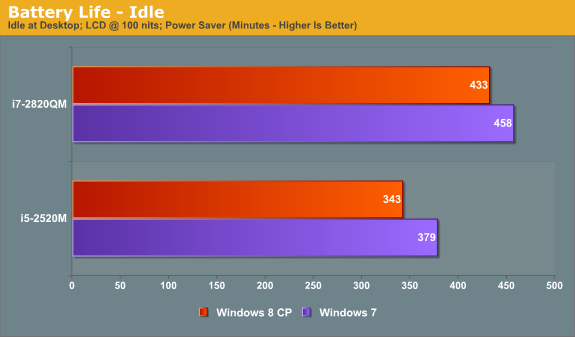
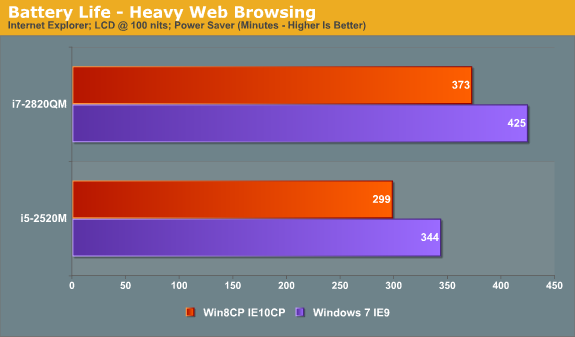
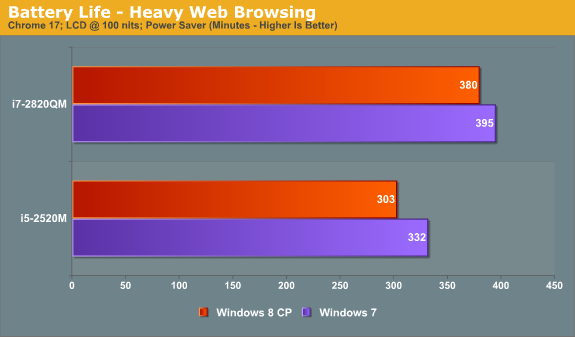
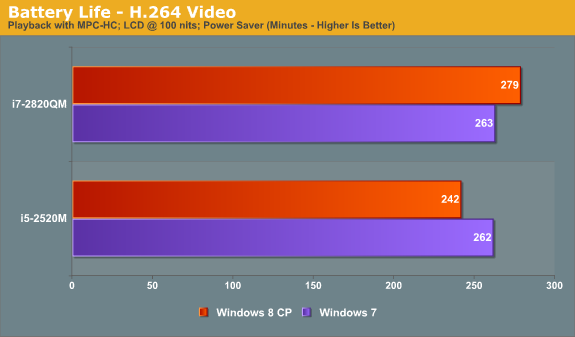

The overall results with our current test laptops have Windows 7 delivering better battery life in most instances. On the ASUS K53E, the advantage ranges from 4% in VLC to as much as 15% in Internet Explorer, but the comparison between IE9 and IE10CP could skew that result more than in other tests. Chrome 17 gives Win7 a 10% advantage, idle battery life is 10.5% better, and MPC-HC battery life is 8% better.
Switch to the Compal notebook and we actually get one discipline where Windows 8 CP comes out ahead: video playback. It’s not exactly clear why the quad-core laptop does better under Win8 in this area, but both VLC and MPC-HC last longer than on Win7—3% longer with VLC and 6% longer with MPC-HC. Elsewhere, however, the lead for Win7 over Win8CP continues. Idle battery life is 6% better, Chrome 17 is 4% better, and in IE9 vs. IE10CP Win7 leads by 14%.
Given that there’s always slight variation between battery life runs, anything less than 3% is probably nothing to worry about, especially considering the early nature of the Win8CP release. Microsoft could easily close the gap by the time the OS ships, and with additional optimizations Windows 8 could even take the lead in most of our benchmarks. Even a 15-20% deficit with IE10CP could disappear by the time the application and OS are fully optimized, and hopefully our earlier experience where Internet battery life for a "well used" Win7 to Win8 upgrades dropped an additional 25% will get worked out.
I should also point out that the use of Flash in the browser battery life tests could be having a very significant impact on IE10CP. I noticed during the tests that the browser loads the pages much more slowly than in IE9 at times—e.g. sometimes it will take upwards of 20 seconds for the main page (a cached version of AnandTech.com) to load, where most other times the page will load in less than five seconds.
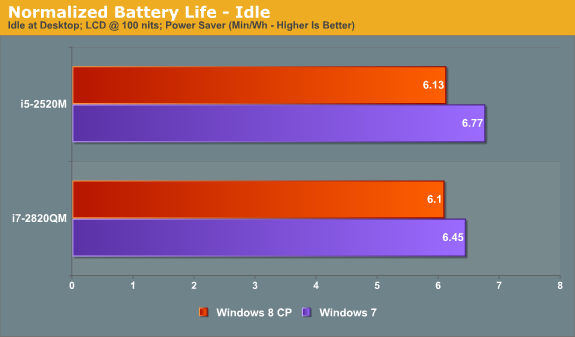



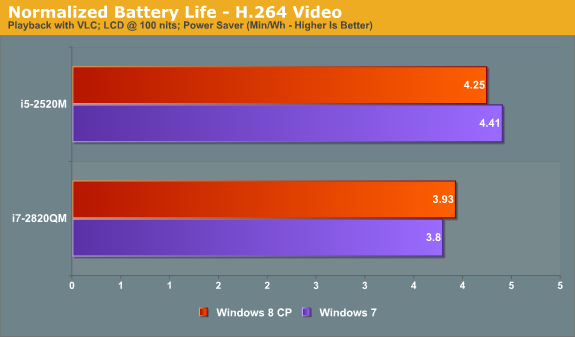
Along with our pure battery life results, we also calculated normalized battery life for the same tests. The ASUS K53E has a 56Wh battery and the Compal notebook has a 71Wh battery, so we simply divide the number of minutes by battery capacity. As expected, the K53E takes the lead over the Compal in all of the normalized battery life results. It has a smaller LCD (and a lower resolution), giving it a particularly large advantage in things like full screen video.
Obviously, we’re still only looking at two laptops, and there are many types of laptop that we haven’t been able to test with Windows 8 CP. Just to list a few items that we can’t comment on right now, we didn’t look at battery life with discrete GPUs from AMD or NVIDIA. Drivers and WDDM1.2 have the potential to change things even more for such laptops. Likewise, we didn’t look at any switchable graphics laptops (NVIDIA Optimus or AMD Dynamic/Manual Switchable). I don't have any AMD-based laptops right now that I can test Win8 on, so the two laptops are relatively recent Sandy Bridge models. All of our current test results also come from laptops with SSDs; my experience in the past two years is that SSD vs. HDD doesn’t make much of a difference for battery life unless you’re specifically placing a moderate to large load on the storage subsystem, but there’s still a chance for something to change.
Long story short [Ed: Too late!], Windows 8 Consumer Preview currently shows slightly lower battery life in most of our tests compared to Windows 7, and Internet Explorer 10 CP shows quite a bit worse battery life than IE9. We wouldn’t worry too much about the drop at this point, though again it’s worth noting that certain combinations of hardware and software could show a larger change than what we experienced—for better or for worse. If you need every last bit of battery life, we’d recommend keeping a backup of your Windows 7 installation handy in case things go wrong with Windows 8 CP, but for typical users and those interested in checking out how Windows 8 is shaping up, factors other than battery life are likely going to be more important to your overall experience.
If there’s any specific type of laptop you’d still like to see us test with Win8CP that we haven’t covered with these two laptops, let us know and we’ll see what we can do, but no promises—we’ve probably already gone overboard with battery life testing on a beta OS! Likewise, if there are other battery life tests you’d like us to run on these two laptops, we can look at that as well. Just let us know what you’d like to see and we’ll try to make it happen.
















286 Comments
View All Comments
Andrew.a.cunningham - Saturday, March 10, 2012 - link
I've seen that from a couple of other people... Not sure how I missed it. It's on a list of small updates I need to make to the article that I hope I can get to tomorrow.Cardio - Saturday, March 10, 2012 - link
I am running Win 8 CP on a new build Asus Z68, SB @4.7, a Mushkin Chronos SSD and a GTX 580.First I think this is an exceptionally well done review. It is an OS review not hardware. There is no reason to think that the OS will work differently on an AMD or an Intel anymore than win 7 did. I am pretty sure that MS knows there are AMD systems out there and is not going to release an OS that will not run properly on them, seems like that would be the best business plan. I, for one, see nothing wrong with Windows 8. It is faster than 7 and has been completely stable for me and compatible with everything I have tried with the sole exception of CPUZ and ASUS's multiple driver install program that sees it as an unknown OS. The drivers still install normally if done separately.
It is different. Most of the complaints I hear are based just on that. Personally, I wouldn't want it if it wasn't different. If you don't want it don't buy it. If you don't want to do things in a different way you sure don't have to... Windows 7 is and will still be around. All this predictable ranting is the same as happened when DOS went away and every other OS change since. I have used Win 8 enough that the changes in use are now normal and you don't have to think about it. I'm sure before RTM and there after there will be more changes. Thanks for the very nice review. I can imagine what a job it was.
taltamir - Saturday, March 10, 2012 - link
"Metro is here, and if you use Windows 8 you’ll have to come to terms with it."Then I wont be using windows 8.
eezip - Saturday, March 10, 2012 - link
Am I the only one that has trouble with this? I can sign in at https://login.live.com/ and have no problems at all, so I figured that was the login info to use.I installed the Dev Preview when it was released and used a local account. But after recalling the Win8 blog post about Win Live ID syncing, I figured I'd try it before moving to the CP. So I went into the settings and selected "Switch to a Microsoft Account". Seems logical. But I was unable to log in again to the Dev Preview install. Arrrrgh!
So, I clean installed the CP and tried using the Windows Live ID login info from the beginning. I got to the desktop, but the first time I restarted the computer, I couldn't log in. I had entered my phone number and hint info, but I never saw how to enter it. And the CP certainly didn't offer to help me when I was clearly struggling. Since I didn't have a local account, I reinstalled the CP using a local account, which brings me to today.
Is my login at https://login.live.com/ the same login that I *should* be able to use for Win8? I can only assume that I'm doing something wrong, but I sure don't know what it might be.
InsaneScientist - Saturday, March 10, 2012 - link
How long is your password?Try just the first 16 characters if it's longer than that.
For whatever (REALLY STUPID) reason, it'll let you enter a password longer than that, but it only uses the first 16 as the actual password.
(See my comment two below yours, and poke around on google. It's a known issue)
If it's not longer than 16 characters... I have no idea.
b_wallach - Saturday, March 10, 2012 - link
Well what is a in depth when there is nothing very in depth at all. With all the systems tested here it's really a drag that you can't dig up a AMD system and the one everyone wants to see is the BD line.Most people have seen enough to say if you wanted to do a run with the new OS it would be with this cpu because of all the guesses and some beta tests that showed a marked improvement with these cpu's.
Running a bunch of lame Intel systems really makes it kind of a joke. If you did not have a good selection of different brands then why not delay it until you have enough systems to call it a in depth review instead of a who cares review. I'm sure most would say the intel's would do good and so nothing worth noting was done that would add to a lot of how much better will a radical cpu design work on it as everything points to this being a top of the list things people want to know about the new OS.
With some win8 beta tests showing a 5-10% increase I'm sure everyone that has the new BD's has been waiting to see this one over any of the no real supprise Intel lines.
As always it leaves a fairly large question mark about just what can expect from a site that has been less than honest about AMD for many years.
It's only lately I've even come back here after what went on with bad reviews and very few when AMD first put out their first FX line that was better but trying to avoid the Intel inside ads all over and great praise for Intels horrible egg cooker cpu made me stop comming here for many years. I can't understand why anyone would not put AMD's new cpus right up front with Window's 8 so we can get a good amount of data over this hugely argued point all over the web.
So no this was anything but a in depth review. It was a candy coated and/or we need to run a filler story to help the hit counter stay busy right???
Before that Pentium 4 fiasco I came here a lot.
After that I started looking at a lot of other sites where the useful data WAS useful. Intel knew what sites to throw a lot of money or inflence as they hit the top sites of the day, Tom's hardware was also doing the same line of crap and like this site I took a few years leave until they could earn back what little trust in them.
I'm sure some other sites will get the AMD BD / Win 8 test done. I can't wait to see if all the flack about AMD and windows had merrit. If not I'll stick with Win 7.
Sorry about being so glib, this IS a good site now, I just hate it when they don't pay much mind about what has been the top interest about windows 8 because AMD has a lot riding on how well their new cpu's will do with it. If it follows the beta tests it would move the AMD right up into the level of being a competitor as they are very close with current Intel cpus in some areas, even pass intel in quite a few other tests and if they see a 5 to 10% it would def. make AMD's cpu a contender. Not a top of the line one but it would put it where AMD wanted to see it run.
Now that would alone make it a in depth review..
It would even be a huge news item to run if AMD can do as well as the WIn8 beta reviews people might not bash it so much. AMD built this design for what could be a very sound call because a huge portion of computer users may or may not know is software is putting more demands, a lot of people run programs that can work very well in the multi-threaded apps as I have seen quite a few new ones use it and it will probably get more demanding use running 2-5 or more progs at the same time. AMD's new cpu does this part very very well.
Oh well, it seems like me most wanted AMD scores because it is very important towards AMD's future if they can pull the scores that the beta revew saw.
It can be compared to buying a upgraded cpu because new cpu's usually give this kind of increase from old cpu's scores and their new cpu's can do.
Still, it's got a lot of potential once people start coding prog's to work well with new cpu designs. Intel hsa had to face this when a lot of their products acted even worse than the current AMD performance numbers.
Even if I'm totally wrong about a details it's funny to read bad stuff about these cpu's. They do have some issues but for the most part they are still a very fast cpu and will run all software pretty darn fast.
Andrew.a.cunningham - Saturday, March 10, 2012 - link
This was a feature review/preview, not so much a performance review/preview. We'll be measuring performance more thoroughly when we have the RTM build in a few months.InsaneScientist - Saturday, March 10, 2012 - link
Maybe because it's an indepth article on the OS itself and not so much a re-review of every piece of hardware released in the last 5 years to see how it'll run Win 8? Sound reasonable?And no, how bulldozer improves (or doesn't) ISN'T what everyone wants... what everyone wants is to know if they'll be able to use the new interface. Talk to anyone who has any experience with Win8 - Metro WILL come up (fast), bulldozer? - not so much.
Oh, and as a side note, I can't speak for the initial release of the A64 vs P4 days, but I started coming here around the time the A64X2 and Pentium D came out, and I rather remember Anandtech calling it like it was... the performance was not too dissimilar, with the A64X2 having an advantage (sometimes a large one - occasionally a disadvantage), but the Pentium D needing and ungodly amount of power and heat to be competitive with it. They've always done a good job of calling it like it is! I've never understood where the claim that they're Intel biased comes from.
Don't get me wrong, I also want to know if it's going to help (and I really hope it does), but it's just not that important. Mostly because CPUs - both Intel's and AMD's - are generally fast enough.
To quote you: "[Bullzoder CPUs] do have some issues but for the most part they are still a very fast cpu and will run all software pretty darn fast."
Yes! That's it exactly! They're fast enough that it's no longer critical to be looking at hardware performance with a new operating system. Instead, when we look at a new operating system, we want to see... well... that operating system.
Furthermore, this isn't a final release. Software development develops features and then the feature set is locked and the codebase is optimized. So performance WILL change between now and RTM (and it would not be fair to AMD to test it now). Features, on the other hand are pretty close to final, so talking about those is fair game.
On the issues that everyone is talking about (Metro, UI, and feature changes), Andrew et al. did an excellent job, and I applaud them for that.
InsaneScientist - Saturday, March 10, 2012 - link
Have they done anything in the CP about that blasted 16 character limit on (live account linked) passwords?This is (in my opinion) by FAR the most egregious step backwards on Windows 8. Why on earth is there a limit on this? It's 2012 for crying out loud!
And the need for an "All" option (which should be the default) in search from the start screen. I'm seriously considering skipping Win8 just because of this.
I don't mind Metro much, it's not my favorite, but I can work with it... but why oh why did the search functionality have to take a step backwards after they got me hooked on it in Win7. :(
I may be able to use it with the keyboard search shortcuts you mentioned, but that's not exactly a ringing endorsement.
MamiyaOtaru - Saturday, March 10, 2012 - link
" In 2009, Windows 7 brought WDDM 1.1, which focused on reducing system memory usage by removing redundant data, and support for heterogeneous GPU configurations, a change that precluded modern iGPU + dGPU technologies such as NVIDIA’s Optimus."I don't think "preclude" means what you think it means